Related Research Articles

Thayendanegea or Joseph Brant was a Mohawk military and political leader, based in present-day New York and, later, Brantford, in what is today Ontario, who was closely associated with Great Britain during and after the American Revolution. Perhaps the best known Native American of his generation, he met many of the most significant American and British people of the age, including both United States President George Washington and King George III of Great Britain.
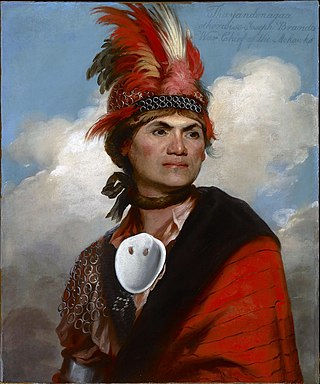
The Kanien'kehá:ka are in the easternmost section of the Haudenosaunee, or Iroquois Confederacy. They are an Iroquoian-speaking Indigenous people of North America, with communities in southeastern Canada and northern New York State, primarily around Lake Ontario and the St. Lawrence River. As one of the five original members of the Iroquois League, the Mohawk are known as the Keepers of the Eastern Door – the traditional guardians of the Iroquois Confederation against invasions from the east. The Mohawk are federally recognized in the United States as the Saint Regis Mohawk Tribe.

The County of Brant is a single-tier municipality in the Canadian province of Ontario. Although it retains the word "county" in its name, the municipality is a single-tier municipal government and has no upper tier. The County of Brant has service offices in Burford, Paris, Oakland, Onondaga and St. George. The largest population centre is Paris.

Six Nations is demographically the largest First Nations reserve in Canada. As of the end of 2017, it has a total of 27,276 members, 12,848 of whom live on the reserve. These nations are the Mohawk, Cayuga, Onondaga, Oneida, Seneca and Tuscarora. Some Lenape live in the territory as well.
Six Nations may refer to:

The Kahnawake Mohawk Territory is a First Nations reserve of the Mohawks of Kahnawá:ke on the south shore of the Saint Lawrence River in Quebec, Canada, across from Montreal. Established by French Canadians in 1719 as a Jesuit mission, it has also been known as Seigneury Sault du St-Louis, and Caughnawaga. There are 17 European spelling variations of the Mohawk Kahnawake.

Kanesatake is a Mohawk settlement on the shore of the Lake of Two Mountains in southwestern Quebec, Canada, at the confluence of the Ottawa and Saint Lawrence rivers and about 48 kilometres (30 mi) west of Montreal. People who reside in Kanehsatà:ke are referred to as Mohawks of Kanesatake. As of 2022, the total registered population was 2,751, with a total of about 1,364 persons living on the territory. Both they and the Mohawk of Kahnawake, Quebec, a reserve located south of the river from Montreal, also control and have hunting and fishing rights to Doncaster 17 Indian Reserve.

The Mohawks of the Bay of Quinte (MBQ) are a Mohawk community within Hastings County, Ontario. They control the Tyendinaga Mohawk Territory, which is a 7,362.5 ha (18,193-acre) Mohawk Indian reserve on the Bay of Quinte in southeastern Ontario, Canada, east of Belleville and immediately to the west of Deseronto. They also share Glebe Farm 40B and the Six Nations of the Grand River reserves with other First Nations.
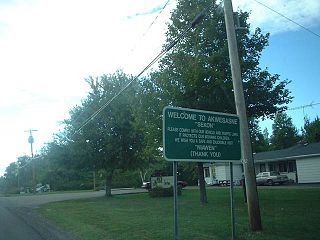
The Mohawk Nation at Akwesasne is a Mohawk Nation (Kanienʼkehá:ka) territory that straddles the intersection of international borders and provincial boundaries on both banks of the St. Lawrence River. Although divided by an international border, the residents consider themselves to be one community. They maintain separate police forces due to jurisdictional issues and national laws.
First Nations in Ontario constitute many nations. Common First Nations ethnicities in the province include the Anishinaabe, Haudenosaunee, and the Cree. In southern portions of this province, there are reserves of the Mohawk, Cayuga, Onondaga, Oneida, Seneca and Tuscarora.

John Norton (Teyoninhokarawen) was a Mohawk chief, Indian Department interpreter and a school master. He was adopted by the Mohawk at about age 30 at their major reserve in Canada. After deserting the British military in the late 18th century, he became a military leader of Iroquois warriors in the War of 1812 on behalf of Great Britain against the United States. Commissioned as a major, he led warriors from the Six Nations of the Grand River into battle against American invaders at Queenston Heights, Stoney Creek, and Chippawa.
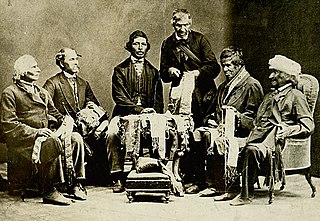
George Henry Martin Johnson (Onwanonsyshon) was a member of the Wolf clan and selected as a hereditary chief of the Mohawk of the Six Nations in Canada; he also served as an official interpreter and informal diplomat between the Mohawk and Canadian governments. His home of Chiefswood, built in 1856 on the Grand River, has been designated and preserved as a National Historic Site; it is the only First Nations mansion from the pre-Canadian Confederation era.

The Haldimand Proclamation was a decree that granted land to the Mohawk who had served on the British side during the American Revolution. The decree was issued by the Governor of the Province of Quebec, Frederick Haldimand, on October 25, 1784, three days after the Treaty of Fort Stanwix was signed between others of the Six Nations and the American government. The granted land had to be purchased from the Mississaugas of the Credit whose traditional territory spans much of modern-day Southwestern Ontario. On May 22, 1784, Col. John Butler was sent to negotiate the sale of approximately 3,000,000 acres of land located between Lakes Huron, Ontario, and Erie for £1180.00 from the Mississaugas of the Credit. Of the land ceded, some 550,000 acres were granted to the Mohawk nation in the Haldimand Proclamation. The sale by the Mississaugas of the Credit is also referred to as the "Between the Lakes Treaty."

Caughnawaga Indian Village Site is an archaeological site located just west of Fonda in Montgomery County, New York. It is the location of a 17th-century Mohawk nation village. One of the original Five Nations of the Iroquois League, or Haudenosaunee, the Mohawk lived west of Albany and occupied much of the Mohawk Valley. Other Iroquois nations were located west of them and south of the Great Lakes.
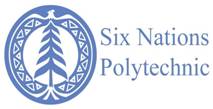
Six Nations Polytechnic (SNP) is a Haudenosaunee-governed Indigenous institute on Six Nations of the Grand River First Nation. SNP is an Indigenous Institute, the third pillar of post-secondary education in Ontario, as recognized by the Indigenous Institutes Act of 2017, The Six Nations of the Grand River First Nation are the Mohawk, Cayuga, Onondaga, Oneida, Seneca, and Tuscarora. The Six Nations of the Grand River First Nation reserve acreage at present covers some 46,000 acres (190 km2) near the city of Brantford, Ontario. Six Nations Polytechnic has two campuses, one located in Ohsweken and one located in Brantford.
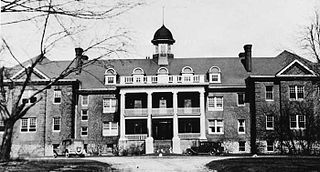
The Mohawk Institute Residential School was a Canadian Indian residential school in Brantford, Ontario, Canada. The school operated from 1831 to June 27, 1970. Enrollment at the school ranged from 90 to 200 students per year.
The Lower Mohawk First Nation is a Mohawk First Nation in southern Ontario, and is a member nation of the Six Nations of the Grand River. Its reserves include the shared reserves of Glebe Farm 40B and the Six Nations of the Grand River First Nation.
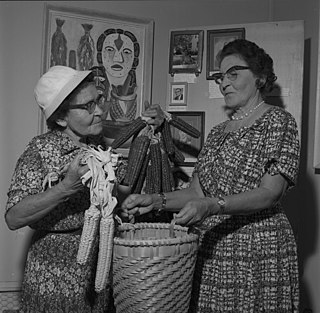
Julia L. Jamieson (1889–1975) was a member of the Six Nations of the Grand River in Canada.
Emily C. General (1908–1991) was a member of the Six Nations of the Grand River reserve in Canada. Born to Alexander General, a Cayuga, and Sophia Jones, who was Mohawk, she was a leader in the community, particularly through her career in education. Prior to becoming a teacher, General fought the RCMP's forced removal of twenty-one children from the community first to the Mohawk Institute Residential School and then to Chapleau Residential School, located 900 kilometres away from their community.